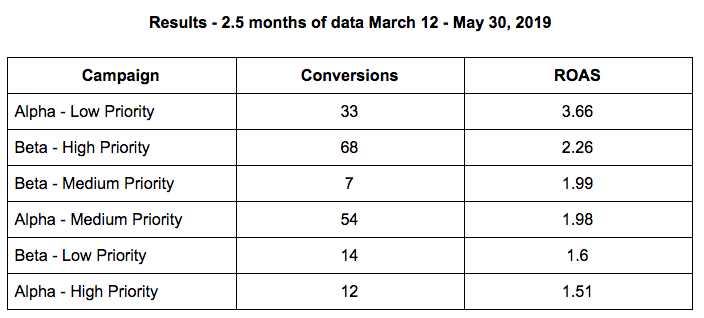Our paid media team constantly strives to push the boundaries with innovative tests around messaging, bidding, audiences, and budget management. Read on to learn how we tested a prioritized alpha beta structure, how it worked and what we learned.
Over the past couple months, we ran a new campaign structure test with a local client in the real estate industry, to improve budget management across re-marketing and prospecting audiences in Google Ads.
The new campaign structure is called Prioritized Alpha Beta, which builds off the commonly used Alpha Beta structure. Performance was different than originally anticipated, but the test yielded great results and actionable insights for future testing.
Purpose & Hypothesis of Prioritized Alpha Beta Structure
The purpose of the Prioritized Alpha Beta is to make sure high priority audiences are fully funded as the ‘core’ target, while low priority audiences are given less budget as the ‘edge’ target. With Google’s increased roll out of in-market and affinity audiences, we wanted to see how these audiences performed against campaigns with re-marketing audiences and no audiences.
The hypothesis was that the high priority audiences would have the best ROI and the low priority audiences would have the worst ROI.

Result of Test
The Alpha – Low Priority campaign with exact match keywords and no audiences won. Initially, we were skeptical and cautious of significantly raising the budget for the Alpha – Low Priority campaign because we thought ROAS would drop and Google was maniacally pushing us to spend more. However, we’ve raised budget 3x what it used to be for the Alpha – Low Priority campaign and it’s maintained the highest ROAS.
The reason the Alpha – Low Priority campaign performed the best was due to its CPC efficiency. It had the lowest CPC of all campaigns at $4.07, while average CPC across all campaigns was $5.63, allowing it to capture more clicks at a lower rate.
Hypothesis failed, test succeeded.
One of the alpha campaigns we deemed as low priority ended up having the best ROAS. The hypothesis was wrong in naming, but the test was successful in pulling 4 key insights and questions around budget management and audience testing.
- The highest CPC came from the high priority alpha campaign at $7.30. The high priority beta campaign had the second highest CPC at $6.46, which also had the highest conversion volume and second highest ROAS. The third highest CPC came from the medium priority alpha campaign at $5.68. Generally, RLSA campaigns cost more, but this test brings up the question, is Google using audiences to drive inflation?
- The high priority alpha campaign was fully funded. It had the second lowest conversion volume and lowest ROAS. The low conversion volume was to be expected given the smaller audience size, but the low ROAS surprised us. Again, this low ROAS is most likely due to the high $7.30 CPC.
- The medium priority campaigns fell in the middle of the pack as intended. Looking at audience attribution, we wondered how Google categorizes users into audiences when they’re so similar? Signals are used to categorize audiences, but how do the signals differ between someone in-market for real estate vs. someone in-market for residential properties?
- It also makes us think critically about the benefits of these new audiences, are they available to provide more granular targeting options, get more advertisers on the platform, to level the playing field or to get advertisers and businesses to spend more? The answer is all of the above.
Conclusion
The Prioritized Alpha Beta structure drove an overall 2.17 ROAS. We found it incredibly helpful in making budget adjustments and have a clear indication of which audiences are performing best, even though it didn’t perform as originally intended.
With the continued increase of audience targeting parameters, like in-market, custom affinity, and custom intent audiences, the prioritized alpha beta structure puts us ahead of the curve and allows us to see how these audiences are actually improving or hurting performance.
Ultimately, the test created as many questions as it did answers, providing new opportunities for our agency to explore and expand the boundaries of paid search.
- Paid Media Marketing During a Recession - September 1, 2022
- The Google Ads ETA Sunset is Coming in July – Get Your Accounts Ready - June 2, 2022
- The Top 6 B2B Paid Media Channels to Test in 2022 - April 5, 2022




